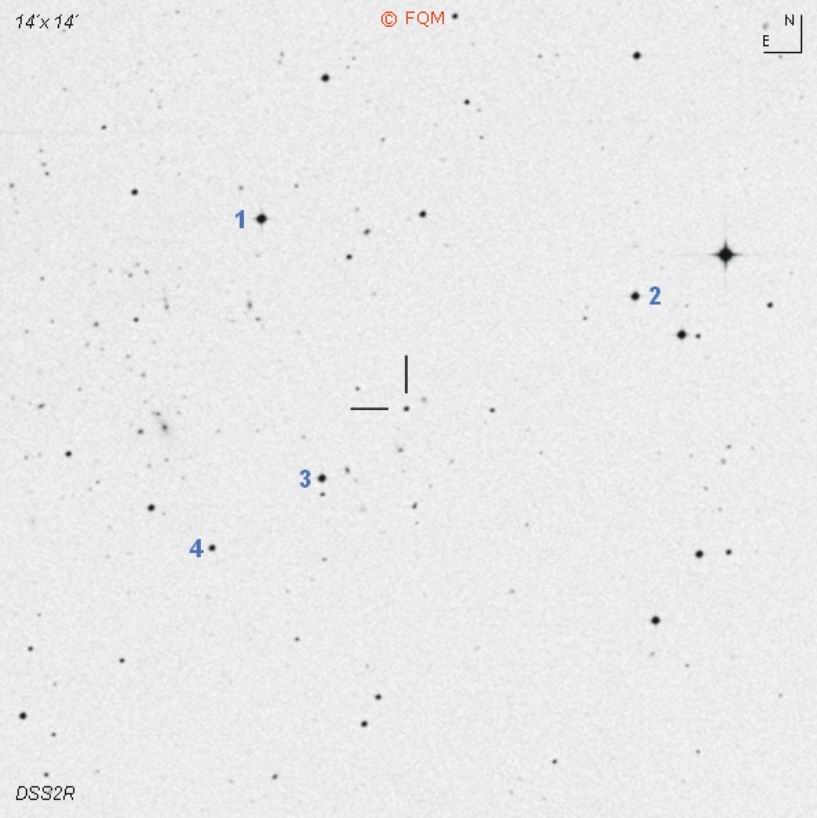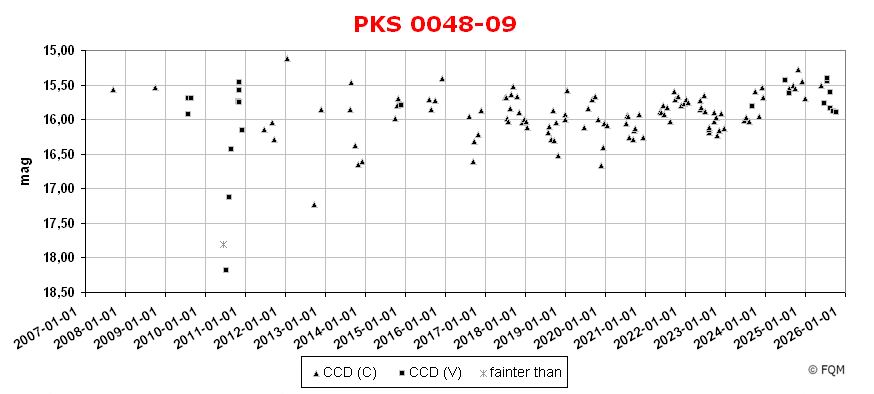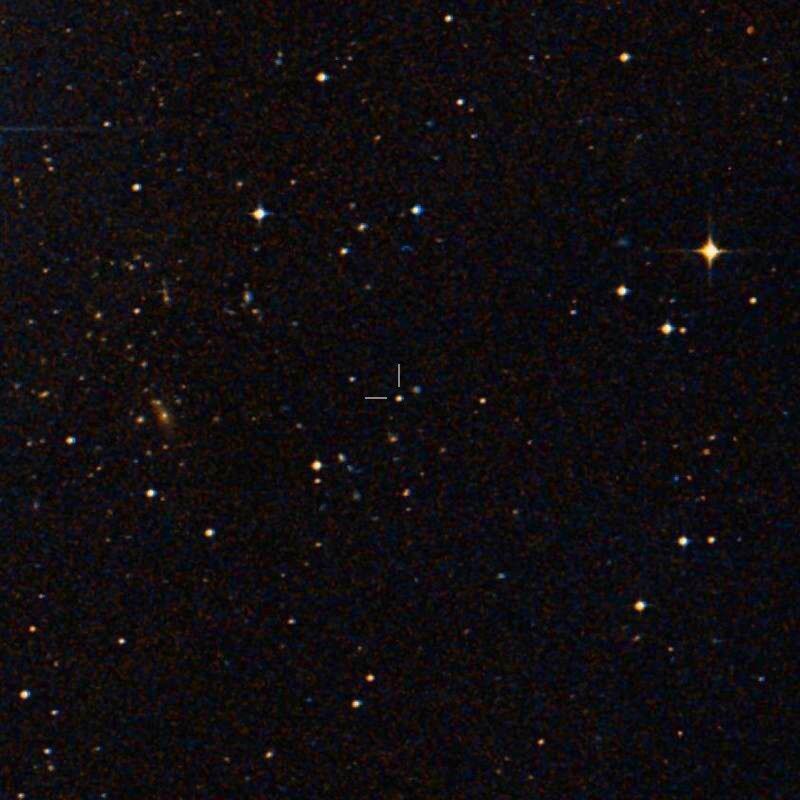
| Frankfurt Quasar Monitoring |
| PKS 0048-09 |
| Cross-Identifications | PKS 0048-097, LEDA 2822375, 0048-097, TXS 0048-097 OB-080, PHL 856, 1WGA J0050.6-0929, QSO B0048-09 1E 0048.1-0945, FBQS J0050-0929, WMAP J0051-0927 SDSS J005041.30-092905.1, 1RXS J005041.0-092855 MC3 0048-097, PKS B0048-097, PMN J0050-0928 FIRST J005041.3-092905, 0FGL J0050.5-0928 |
| Equat. coordinates | RA 00 50 41.2 DE -09 29 06 (J2000) |
| Constellation | Cetus |
| Type | BL Lac |
| Redshift | z=0.635 (2) (5) (6) |
| Distance (2) | 2244 Mpc |
| Total mag range (mv) (3) (4) | 14.50 - 18.08 |
| Catalog Magnitude | 17.44 mV (1) / 16.22 mV (6) / 18.36 mB (2) |
| Absolute Magnitude (1) | --- MB |
| Light Travel-Time (2) | 5.743 × 109 yrs (2) |

Comparison stars
| star | V | Rc |
| 1 | 12.77 (0.04) |
12.47 (0.04) |
| 2 | 13.86 (0.02) |
13.33 (0.03) |
| 3 | 14.12 (0.03) | 13.55 (0.02) |
| 4 |
15.00 (0.02) | 14.60 (0.04) |


| PKS
0048-09 is a violently variable BL Lac object in western Cetus, about
2.5° NE of bright planetary nebula NGC 246.
The designation PKS 0048-09 refers to the Parkes Radio Survey (PKS),
where
this object was catalogued as a radio source. As such, PKS 0048-09 has
been catalogued by various other radio surveys. VLBI images
found evidence for a radio jet heading to the southeast. In 1980, PKS
0048-09
was confirmed as a BL Lacertae object. The host galaxy of PKS 0048-09
is assumed to be an elliptical. A faint close companion was found about
2.5" E of the BL Lac nucleus and might be associated with the BL Lac
object itself. Besides
the optical and radio, blazar PKS 0048-09 has been detected also as a source of
both X-rays and gamma emissions. With a total range of more than 3 magnitudes in the optical, this blazar shows all typical properties of its class: strong flux variability, a high degree of polarization and a (nearly) continuous spectrum. Prior to 2012, no confirmed redshift had been determined for PKS 0048-09. A lower limit of z~0.2 was derived by Stickel et al. (1993) from the absence of the extended nebulosity of the host galaxy, which is typically found with less remote objects. So the redshift was either z=0.216, or even z > 0.5 (see Rector et al. (2001) for further details). Then in 2012, the first reliable redshift of z=0.635 was published (Landoni et al. 2012). The observations were carried out in summer 2010 with the X-Shooter spectrograph at the Very Large Telescope (ESO). At that time, the blazar was in optical low state (see light curve above), so it was possible to detect faint emission lines in the spectrum. A redshift of z=0.635 corresponds to a light travel-time of 5.7×109 light-years. A note regarding the cross-identification: PKS 0048-09 is often misidentified with OB-081. In 6/2010-7/2010, a new historical optical minimum for PKS 0048-09 was recorded during Frankfurt Quasar Monitoring programme. With a magnitude of 18m.08, it surpassed the faintest ever recorded magnitude of 17m.44 from the literature by 0.6 magnitudes. So the documented total optical range increased from 3 magnitudes to 3.6 magnitudes. ____________
One deep sky showpiece near PKS 0048-09 shall not be missed: planetary
nebula NGC 246. Only 2.5° SSW of the blazar we find this 8-mag bright
and large planetary. It has an
apparent diameter of 4 arcmin (!) and lies about
1600 light-years away from earth. Use an UHC or O-III filter to improve
the visibility of this planetary. Those observers who like to focus on some more very old quasi-stellar photons may turn to quasar TON S180, a bright 14-mag object at a distance of about 0.8×109 light-years, 13° S of PKS 0048-09. |
| Adam, G. 1985, A&AS 61, 225; UBV photometry of quasars and quasar candidates. II. Falomo, R., Scarpa, R., Bersanelli, M. 1994, ApJS, 93, 125; Optical spectrophotometry of blazars. Falomo, R. 1996, MNRAS, 283, 241; Host galaxy and close environment of BL Lacertae objects. Gabuzda, D.C., Pushkarev, A.B., Cawthorne, T.V. 1999, MNRAS, 307, 725; The lambda=6cm VLBI polarization structure of nine BL Lacertae objects. Kotilainen, J.K., Falomo, R., Scarpa, R. 1998, A&A, 336, 479; The host galaxies of BL Lac objects in the near- infrared. Landoni, M., Falomo, R., et al. 2012, A&A, 543, 116; On the redshift of the bright BL Lac object PKS 0048-097. Rector, T.A., Stocke, J.T. 2001, AJ, 122, 565; The Properties of the Radio-Selected 1 Jy Sample of BL Lacertae Objects. Steinicke, W.; Katalog heller Quasare und BL Lacertae Objekte; Umkirch 1998. Stickel, M., Fried, J.W., Kuehr, H. 1993, A&AS, 98, 393; The complete sample of 1 Jy BL Lac objects. II - Observational data. Torniainen, I., Tornikoski, M., et al. 2005, A&A, 435, 839; Long term variability of gigahertz-peaked spectrum sources and candidates. Véron-Cetty, M.-P., Véron, P. 2001, A&A 374, 92; A Catalogue of Quasars and Active Nuclei: 10th edition. Véron-Cetty, M.-P., Véron, P. 2003, A&A 412, 399; A Catalogue of Quasars and Active Nuclei: 11th edition. Véron-Cetty, M.-P., Véron, P. 2006, A&A 455, 776; A Catalogue of Quasars and Active Nuclei: 12th edition. Véron-Cetty, M.-P., Véron, P. 2010, A&A 518, 10; A Catalogue of Quasars and Active Nuclei: 13th edition. Villata, M., et al. 1998, A&AS, 130, 305; BVR photometry of comparison stars in selected blazar fields. I. |
| Link: Landessternwarte Heidelberg |
| home |